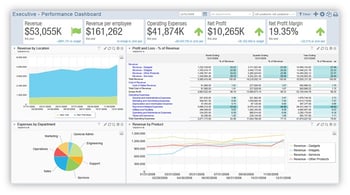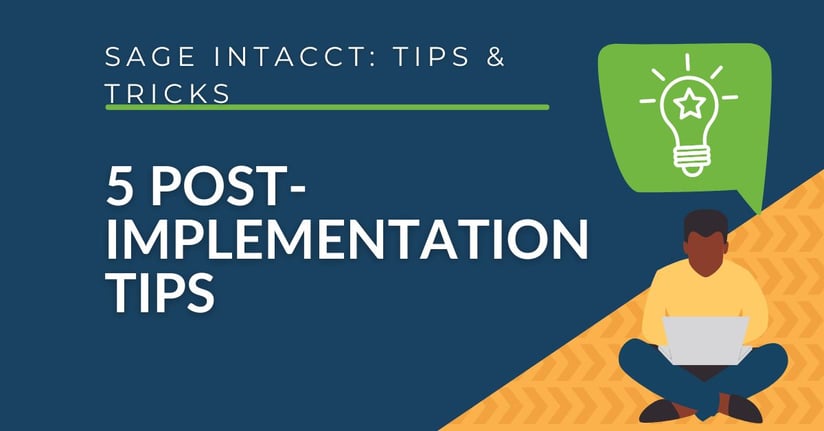CONGRATULATIONS! Your Sage Intacct implementation is over and so that means you have nothing else to do right? Wrong. Just because you went live doesn't mean that you can't continuously find ways fully leverage the benefits of Sage Intacct. Here are 5 different ways to continually improve your business processes.
Re-evaluate your business processes
This is a critical first step during and after an Intacct implementation. This process involves reviewing tasks performed manually and identifying areas that are time-consuming, prone to errors, or need additional support. By identifying these areas businesses will be able to leverage Intacct to automate or streamline them, allowing the finance team to focus on more critical tasks.
Re-evaluating workflows and procedures requires businesses to take a hard look at their current processes and ask some critical questions. For example, how can we automate more critical tasks? What do we need to do to provide better support to our teams? By identifying these questions businesses can go deeper into Intacct’s capabilities to identify areas that can support these needs.
Use your Reports and dashboards features
 On of Intacct’s most robust features is its real-time financial reporting capabilities. By utilizing customized dashboards and reports, businesses can gain insight into their finances, identify areas that need attention, and make informed business decisions. The reporting functionality of Intacct allows the finance team to produce reports more quickly and with great accuracy. Additionally, these reports will be valuable for identifying areas that need improvement, such as revenue leakages or growing expenses.
On of Intacct’s most robust features is its real-time financial reporting capabilities. By utilizing customized dashboards and reports, businesses can gain insight into their finances, identify areas that need attention, and make informed business decisions. The reporting functionality of Intacct allows the finance team to produce reports more quickly and with great accuracy. Additionally, these reports will be valuable for identifying areas that need improvement, such as revenue leakages or growing expenses.
Intacct provides a large selection of pre-built reports that businesses can choose from. In addition, these reports can be modified to suit industry or specific business needs. Custom dashboards track critical business metrics, such as, cash flow, sales revenue, outstanding invoices, and payments. Leveraging these features provides businesses with the ability to monitor their business performances, identify emerging trends, and respond more quickly to them.
» Check out this video to walk-through Intacct's Reporting features and more!
Leverage Integration
Intacct’s integration with other business systems such as CRM systems, can streamline business processes even further. This integration allows data to flow freely between systems, eliminating the need for manual data entry, reducing the likelihood of errors. For example, integrating Intacct with a CRM system allows businesses to track sales more effectively and apply revenue recognition policies with greater accuracy.
Intacct provides a REST-based API that businesses can use to integrate their systems effectively. The API not only allows integration with standard processes but also custom processes that businesses may need. The API documentation and development resources are extensive, providing businesses with greater flexibility to automate these processes.
Enhance compliance
Improving compliance is another essential step businesses can take after implementing Intacct. Intacct provides audit trails, data security, and other features to ensure compliance with regulatory standards like GAAP and IFRS. Businesses can use these features to implement standard accounting procedures, reduce the risk of fraud, and maintain more accurate financial data. Furthermore, these compliance features can help businesses manage risk more effectively.
Businesses can enhance their compliance by reviewing their existing accounting policies and procedures to ensure they align with the platform’s capabilities. This process may involve validating and testing the accounting policies and procedures by creating test scenarios to identify areas that need improvement or adjustments.
Provide ongoing training
Ongoing training for Intacct users is essential to continually improve business processes. Training helps the finance team understand Intacct’s features and functionality, how to use them effectively, and how to get the most out of the system. Additionally, ongoing training can help identify new opportunities to optimize processes further and stay up-to-date with the latest Intacct releases and features.
Want more tips about Sage Intacct?
Make sure to subscribe to our blog and check out some of these articles!
» Sage Intacct Budget Reports...IN ACTION!
» Tips & Tips: Navigating Sage Intacct with Shortcuts
» How to use Sage Smart Rules in Sage Intacct




